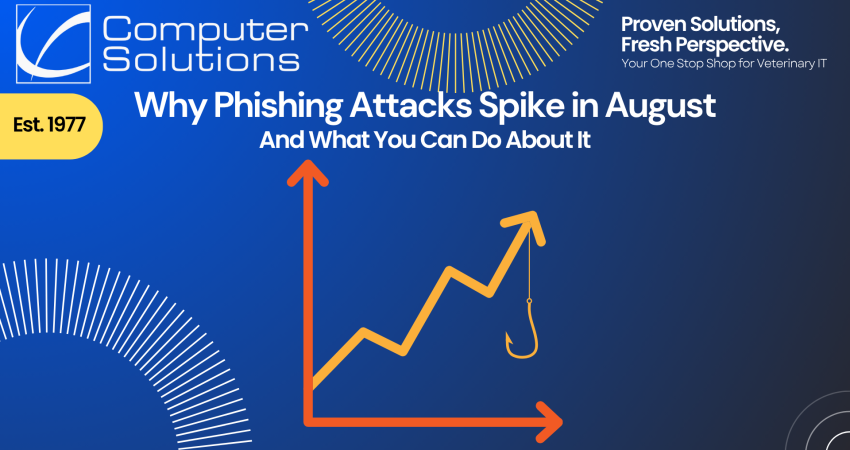
Posted by Computer Solutions on August 18, 2025
For veterinary practice owners and managers, late summer usually means vacations, back-to-school chaos, and the slow ramp-up to a busy fall. But while you and your team may be taking time off, cybercriminals aren’t. In fact, phishing attacks tend to spike in August, and small businesses like yours are often caught off guard.
Why? Because this time of year presents a unique blend of distractions—travel plans, busy inboxes, and staff working from different locations. All of that creates the perfect environment for a successful phishing attempt.
According to research by ProofPoint and Check Point, phishing activity rises noticeably during the summer. In May 2025 alone, researchers discovered a 55% increase in new travel-related website domains compared to the previous year. Of the 39,000 domains created, one in every 21 was flagged as malicious or suspicious.
Whether it’s fake hotel booking sites, phony password reset emails, or AI-crafted messages posing as legitimate vendors, phishing attacks are getting smarter—and sneakier. If your clinic isn’t prepared, a single click could compromise sensitive client data, shut down operations, or cost you thousands in remediation and recovery.
Why Summer Makes You More Vulnerable
Attackers know how to exploit seasonal patterns. During the summer, they often mimic:
- Hotel or vacation rental websites (like Airbnb)
- Airline confirmations or boarding pass links
- School-related emails during back-to-school season
- Shipping updates or travel insurance messages
While these might seem unrelated to your veterinary clinic, it only takes one employee checking personal email on a work computer to open the door. Once inside, malware can move laterally across your network, targeting client data, imaging systems, payment platforms, or anything else accessible.
That’s why having a set of phishing protection tips in place—and making sure your entire team follows them—is essential.
7 Practical Ways to Defend Against Phishing Attacks
You don’t need a full-time cybersecurity team to stay protected. Here are some simple, effective steps your clinic can take today.
1. Inspect Emails Carefully
AI has made phishing attacks more convincing than ever. Misspellings and poor grammar are no longer reliable red flags. Instead, look at the email address itself. Is it spelled correctly? Does it match the domain of the real sender?
Before clicking links, hover over them to see the destination. Watch for suspicious domain endings like “.info,” “.top,” or “.today,” which are frequently used in scams.
2. Avoid Clicking on Email Links
If a message urges you to “log in now,” “confirm details,” or “reset your password,” don’t click the link. Instead, go to the website directly by typing the address into your browser. This small step eliminates a huge percentage of phishing risk.
3. Use Multifactor Authentication (MFA)
Even if login credentials are stolen, MFA can stop attackers from getting in. Use an app-based method (like Microsoft Authenticator) rather than text message codes, which are more easily intercepted.
4. Keep Work and Personal Activity Separate
Encourage your staff not to check personal email, bank accounts, or social media from company devices. While it might seem harmless, it dramatically increases the odds of accidentally downloading malware or visiting a fake website.
5. Be Wary of Public Wi-Fi
Traveling staff or remote workers should always use a VPN if they connect to public Wi-Fi. Open networks at hotels, airports, and cafes are frequent targets for attackers looking to intercept login credentials.
6. Train Your Team
Phishing awareness isn’t a one-time email—it should be part of your clinic’s ongoing cybersecurity education. Hold short, quarterly refreshers or send real-world phishing examples to test and reinforce what staff should watch for.
Sharing phishing protection tips regularly can build good habits and help reduce the risk of someone clicking in a moment of distraction.
7. Ask About Endpoint Protection
If you work with an IT provider, ask them if your devices are protected by endpoint detection and response (EDR). EDR tools monitor for suspicious behavior, detect and block phishing-related downloads, and alert your IT team immediately—stopping damage before it spreads.
Why This Matters to Veterinary Clinics
Veterinary practices may not seem like obvious targets, but cybercriminals know they’re often under-protected. Your practice may handle client financial information, insurance forms, lab system data, or even prescription details—all of which are valuable to attackers.
And if your clinic goes offline due to a phishing-based ransomware attack, you can’t serve patients, access records, or process payments until it’s resolved. The cost isn’t just technical—it’s operational and reputational.
That’s why these phishing protection tips are about more than compliance or best practices. They’re about protecting your ability to care for pets and serve your clients, every day.
Don’t Wait for a Mistake to Make a Change
Cybercriminals don’t need to break in. They wait for someone on your team to open the door.
We help veterinary clinics across NJ, PA, and NY reduce that risk with practical training, strong endpoint protection, and clear communication.
Start the season secure.
Book your free cybersecurity assessment today at welinku.com and let’s find the weak spots—before someone else does.
Want to learn more about veterinary IT and cybersecurity? Check out another blog post here!
Discover more from Computer Solutions
Subscribe to get the latest posts sent to your email.







